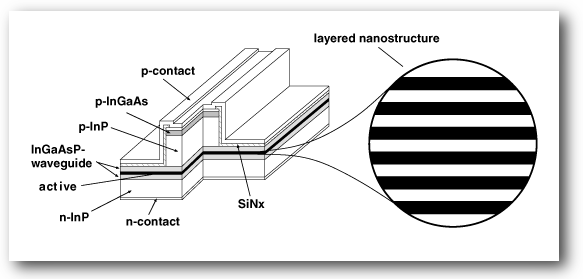
Scheme of a Ridge-Waveguide (RW) Strained Multi Quantum Well (SMQW) laser diode
(Design by Heinrich-Hertz-Institut für Nachrichtentechnik, Berlin)
The design of state of the art optoelectronic devices like semiconductor lasers is based on semiconductor nanostructures like Multi Quantum Wells.
The role of semiconductor nanostructures will increase in the future due to the advent of quantum electronic devices which is assisted by the increasing sophistication of fabrication technology. To understand and to predict the physical properties of such devices, new theoretical techniques for the computation of their electronic states are required.

The ab initio solution of the many electron Schrödinger equations on the microscopic scale fails due to its computational effort. To overcome the computational burden, it appears to be natural to utilize the presence of two scales inherent to the problem - the mesoscopic scale of the variation of the materials in the nanostructure and the microscopic scale of the atoms of each material.
The most promising approach for nanostructures has been proposed by Burt (J. Phys. Condens. Matter 4, 6651 (1992); ibid. 11, R53 (1999)), who introduces envelope functions, which describe the slowly varying mesoscopic part of the locally highly oscillating microscopic wave functions.
Burt points out a way to derive equations for the envelope functions in terms of the microscopic potential. One arrives at pseudodifferential equations for the envelope functions in real space or integral equations for Fourier transformed envelope functions.
The aim of this project is a mathematically rigorous foundation of Burt's approach together with an investigation of the involved operators ultimately the development of efficient numerical methods for solving the arising equations.
On success, an efficient modeling and simulation tool for nanostructures will be available for physicists and engineers.
A. Arnold, M. Ehrhardt, A. Zisowski
W. Dreyer
A. Jüngel